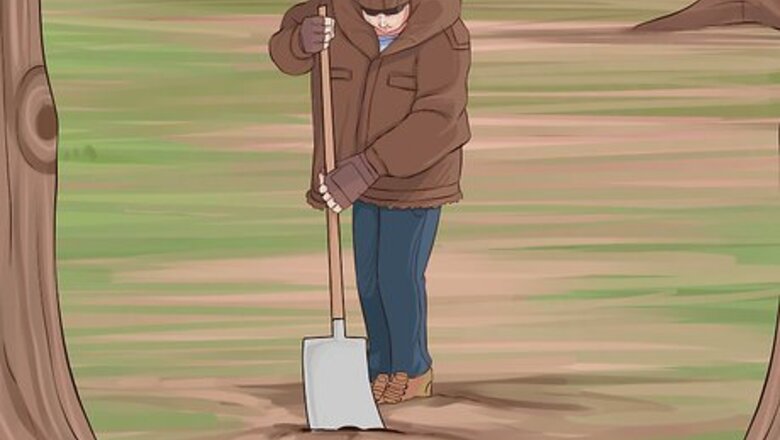
views
- Lay 2 pieces of firewood parallel to each other, then stack 2 more logs on top that are perpendicular to the base. Build a few more layers like this.
- Arrange tinder and kindling around the base of the wood and light it to get the fire going.
- When you're done, extinguish the fire completely by pouring water over it.
Build a fire ring in a safe location.
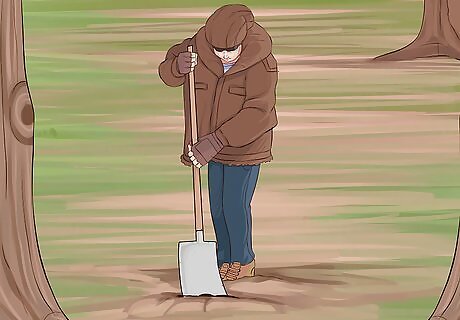
Create a fire ring if you can't find one and your camping site allows it. Use a shovel to clear a circle of bare dirt about 10 feet (3.0 m) wide. In the center, dig a shallow fire pit 2 feet (0.61 m) wide and 6 inches (15 cm) deep. Use dirt or medium-sized stones from nearby to build a circular barrier around the central pit. Look for a spot on level ground away from overhanging branches, dry grass, or brush. Stay away from the bases of any hills (escaped fires travel quickly uphill). Whenever possible, it’s best to use an existing fire ring to safely contain your fire and preserve the beauty of the campground or backcountry.
Collect your tinder.
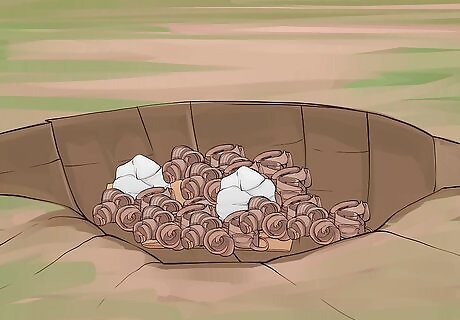
Tinder is any very dry, small material that will catch fire quickly. Look for tiny dried twigs, dry leaves or grass, or pine needles to start your fire with. You can even use crumpled newspaper or dryer lint from home if you plan ahead. Place your tinder in the center of your fire ring. More options for making tinder for your fire could be wood chips or shavings, pieces or strips of cardboard, candle wax, cotton balls, or a commercial fire starter. All of your tinder material—including twigs or sticks—should be small enough to fit in your cupped hands and very thin (around the width of pencil lead).
Gather kindling and firewood.
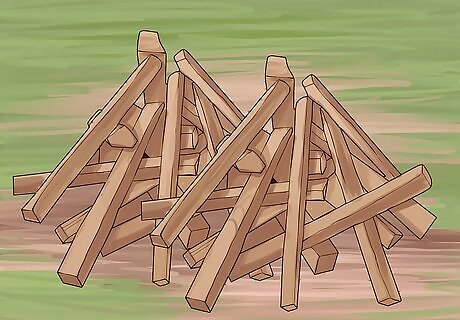
Look on the ground for dry, dead sticks and branches. The best kindling sticks will be about 1 inch (2.5 cm) wide and long enough to reach from your elbow to your fingertips. Firewood will be larger—about the thickness of an adult wrist (or more) and as long as an arm. Buy firewood or kindling from a store near the campground if your site or park doesn’t allow collection, like in many national parks. Only use firewood found or bought near the campsite. Wood from home can harbor pests that can interfere with the site or park’s local ecosystem if they escape and spread. Keep large piles of kindling and firewood near the fire so you don’t have to leave it unattended to gather more.
Arrange the kindling and firewood.
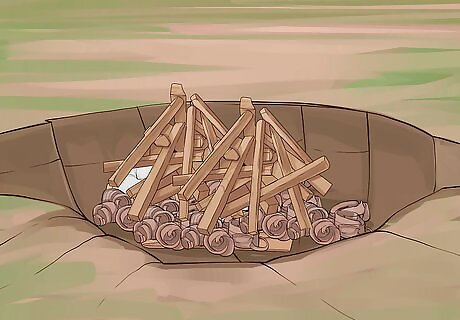
Fires for cooking or for warmth require different arrangements of wood. While any configuration can technically work, set up your kindling and firewood for success based on your needs. Here are some common and useful ways to build your campfire: A teepee fire is simple and effective. Lean your kindling together to make a teepee (cone) shape over your tinder. Leave space between the sticks so air can feed your flames. As the fire grows, add bigger pieces of firewood. A log cabin fire is great for long lasting warmth. Lay 2 large pieces of firewood parallel to each other. Put 2 more logs on top, perpendicular to the base. Build a few more layers like this, then make a teepee with kindling around the base. Build a platform fire to cook over your open flames. Make a base of 2 or 3 large logs lying horizontally. Then place smaller logs vertically on top. Build a small teepee of kindling at the very top so the fire burns downward. Build a star fire when you’re low on firewood. Make a small teepee with kindling, then lay several logs around the teepee so that only one end of each log is touching the teepee. The logs will be slowly consumed by the fire. Make a lean-to fire to protect against wind and rain. Put down one large log, then lean smaller pieces of firewood against it perpendicularly to make a lean-to. Make a mini-teepee under the lean-to.
Light the fire.
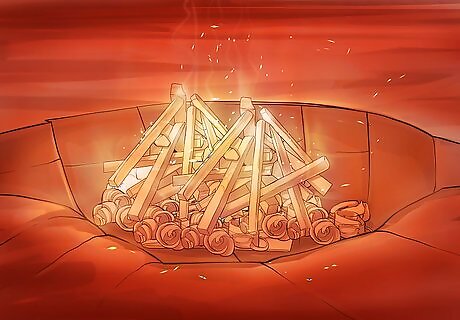
Ignite the tinder first to spread fire to the kindling and firewood. Once the tinder catches the kindling on fire, keep adding kindling to sustain and grow the flames. Add firewood once the fire is large and stable enough to light bigger pieces of wood. For safety, use only matches, a lighter, or a small amount of lighter fluid if the tinder won’t catch. As you add wood, leave room for air to circulate within the fire. Only use dry kindling and firewood when possible (it burns easier and smokes less). Besides lighter fluid, avoid other accelerants (chemicals that ignite raging fires) like gasoline since they can easily burn out of control and become dangerous. Never squirt or spray lighter fluid or any other chemicals onto embers or an open flame. This could result in sudden flare ups, burns, or spreading the fire.
Put out your fire.
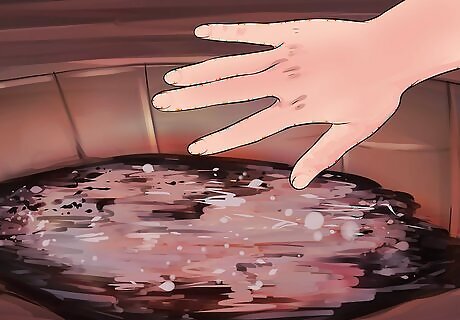
Fully extinguish your fire since burnt wood can stay hot for hours. A gust of wind can reignite or spread embers when you’re not looking, so this is extra important. Check to see if your campfire is still too hot to touch. If it is, pour water over the fire, logs, and pit to put it out completely. If you don’t have water, cover the embers and logs with dirt. Use a poker or shovel to continually stir the dirt and embers around until they are fully extinguished. It's best not to use sand to cover a campfire. The fire may look like it's out on the surface but still burn underneath the sand (because it's insulating). If sand is all you have available, make sure to stir it around and put out the embers, not just cover the fire. A good rule of thumb for putting out campfires is “if it’s too hot to touch, it’s too hot to leave.”
Cleanup all traces of your fire.
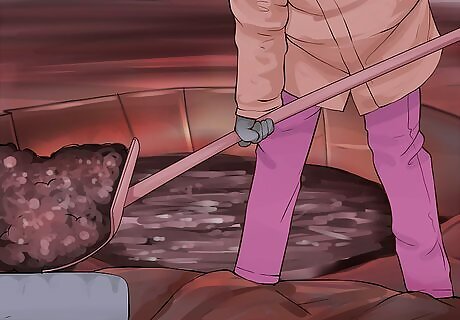
"Leave no trace” of your fire to reduce your impact on the environment. Replace any soil you used where you found it, and scatter unburnt wood to make the area look as natural as possible. Make sure your wood or coals are completely burnt and crushed into dust, then scatter them over a large area away from your campsite. Clean up any litter, including uneaten food you roasted or garbage you burnt, and dispose of it according to the rules of your campsite. Wait until your fire is completely extinguished and cool before you begin cleanup.




















Comments
0 comment